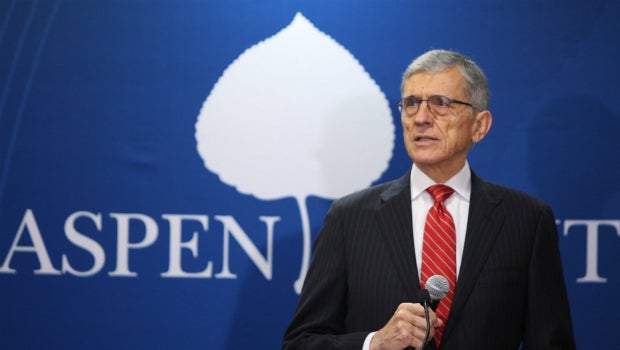Former FCC Chairman Tom Wheeler is a senior fellow in the Aspen Institute Communications and Society Program. The views and opinions of the author are his own and do not necessarily reflect those of the Aspen Institute.
In 2015 the Federal Communications Commission revised and expanded the E-Rate Program that supports connectivity for America’s schools and libraries. The results speak for themselves. At the time, one-third of schools had no high-speed fiber access. Even among those that did, that access wasn’t reaching students’ desks in 75 percent of schools. Today, according to Education Superhighway, 95 percent of schools have high-speed fiber and in 83 percent that high-speed connectivity extends to each student’s desk.
The E-Rate reforms that delivered this success were approved by a 3-2 party-line vote by the FCC. Today, those who voted to oppose the improvements are in control of the agency and the program. When American educators are staring down the barrel of the Trump budget cuts to education programs, it is appropriate to ask what the Trump FCC will do about the third-largest federal support of education program.
Thus far, the talk has been about closing the digital divide and fighting waste, fraud and abuse – good goals, all. The test will come when decisions move beyond the rhetoric. The new chairman has suggested there should be changes in the way in which E-Rate funds are allocated, including the adoption of a per-pupil formula. Again, the rhetoric sounds good, all about closing the digital divide and helping rural America.
Until we see otherwise, we should take the Trump FCC at its word that it’s serious about improving the E-Rate program rather than cutting the number three federal aid to education program (like the Trump budget proposes for number one and number two). But those who propose changes must do what any 10th grader would do: their math homework.
So, for this homework assignment, let’s ask four questions.
First, what would be the financial impact on rural schools? As chairman, I asked the team to look into a per-pupil formula for E-Rate. With four times as many students in urban schools as in rural schools, it quickly became clear that basing support on a per pupil calculation would divert money away from rural areas, leaving millions of rural students behind. Per-pupil allocations mean rural schools pay a whole lot more for a whole lot less.
Second, how would per-pupil allocations affect the access of rural schools to fiber? Before my team left office we sent a report to Congress that said that, while the number of schools without fiber declined by 61 percent from 2015 to 2016, an estimated 3,700 schools still lacked high-speed fiber connections. We proposed that for these most vulnerable schools the E-Rate program had to step up and do more. As soon as the Trump FCC took office, however, the idea of special help for special needs was dismissed as not being FCC policy. Instead of recognizing that about 10 percent of schools have special needs deserving of special support, the new administration hides behind a smoke screen of alleged waste, fraud, and abuse.
Third, how would the proposals affect current activities? After we approved the E-Rate modernization order, 42 governors – Republicans and Democrats representing urban and rural communities – stepped forward to make connecting their schools to the future a statewide priority. Many of these governors have set up, or are in the process of establishing, state matching funds that will collectively provide more than $200 million of funding to build fiber to schools that need it. We need to ensure that governors’ incentives to meet the unique needs of their states aren’t taken away by a one-size fits all E-Rate formula that removes the incentive for both Republicans and Democrats to include school fiber infrastructure in their budgets.
Fourth, what kind of fiscal deficit for rural schools might be created by this change? If the result is to ask rural schools to pay a higher percentage of their broadband costs, how will they come up with the necessary funds at a time when their budgets are under increasing pressure? The marketplace evidence is that rural schools need more support, not less, from E-Rate for the capital costs necessary to give their students equal access to educational opportunity.
Reform of the E-Rate program has been a huge success for America’s schools and students. Now the people who voted against it are in charge. I hope they do their math homework while remembering their ABCs: Access Benefits Children.


